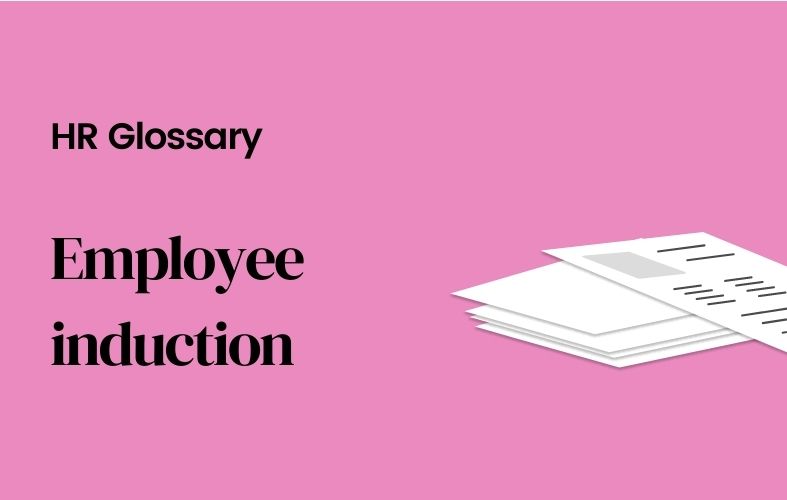Employee induction

[Sommaire]
What is an employee induction?
Employee induction is the process by which new employees have an introduction to the organization they will be working for. It is part of the onboarding process and is where a new employee learns about the values and culture of their employer and their new role.
The new employee will often have anxieties about their new role. This makes it especially important that their employer tries to create a positive first impression of the business. For example, a CIPD study back in 2020 found that 42% of organizations are now improving their induction programs to maximize retention.
What are the main steps for employee induction?
There are three steps to the employee induction process. These include:
General orientation:
Guided tours of the organization, meeting work colleagues, and pieces of information about company's culture.
This is where the new team member is given general information about the company, such as the history of the organization, the company culture, and the structure of the organization.
Specific orientation:
This is where specific work expectations of the employee are outlined. For example, the new employee might be given training on how to use the company's software systems.
Follow-up orientation:
Done after the initial induction (up to six months afterward). The purpose of this is to see how well the new employee has settled in and to give them any additional support they might need.
What are the benefits of employee induction?
There are many benefits of a successful employee induction program. For example:
Reduced staff turnover:
A good induction program helps to engage new employees and ensure they feel valued by their employer. As a result, they are more likely to stay with the company for longer.
Increased productivity:
A new employee induction program helps employees to understand their roles and what is expected of them. As a result, they are more likely to be productive in their role.
Improved engagement:
An effective induction program helps employees to feel engaged with the company. It can happen before the employee starts work (for example, sending information about the company culture) or during the first few weeks of employment.
Encourages two-way communication:
The induction plan is a two-way process; it allows the employer to learn about the employee and their goals and ask questions about the company.
Builds trust:
It is an ongoing process that helps to build trust between the employer and the employee. It can help ensure that the employee feels comfortable in their new role and understands what is expected of them.
What are the main stages of employee induction?
There are four main stages of new employees induction:
1. Pre-arrival:
This is where the employer prepares for the arrival of the new employee. For example, the employer might send out information about the company culture.
2. Arrival:
This is where the new employee arrives at the company and starts the induction process.
3. Training:
This is where new employees are given induction training on their specific roles and on the company's systems and procedures.
4. Follow-up:
This is where the employer checks in with new employees after the initial induction period (up to six months afterward) to see how they are settling in and to give them any additional support they might need.
The employee induction process helps new employees to settle into their roles and feel comfortable in their new environment. It can happen before the employee starts work (for example, sending information about the company) or during the first few weeks of employment (probation period).
What is a good employee induction program?
A good employee induction program is one that:
- Is tailor-made to the background of an individual employee: This contrasts with a standardized induction program which can come across as impersonal and lacking connection.
- Provides a mix of session types: For example, one-to-one sessions combined with group discussions.
- Is partially delivered: For example, the employer can contact employees sometime before their start date with information about the induction process. This can make the employee feel like a valued member before they even start.
- Includes mentorship with a work “buddy”: Positive work socialization with a work colleague/s is a key component for how well the new employee settles in.
- Incorporates creativity to enhance the learning environment: Employers do not need to stick to ‘classroom’ style inductions. More creative ideas such as Drum beating stress buster sessions and theater workshops have been reported as innovative inclusions in inductions.
- Encourages employee feedback: Some employers encourage this as a way to improve their future employee induction programs.
Other elements that should be included in an employee induction include:
1. Health and safety information
2. Role clarification
3. Personnel information such as payroll details and complaints procedures
4. An overview of the company’s history, services, and plans
5. Recreation services and social benefits information.
Who should do the employee induction?
A mix of people can carry out employee induction. It is best for the HR department to lead the process, but it is not something that should be left solely to the HR department.
The HR department, however, is responsible for sharing details such as the employment contract (collecting personal info such as payroll info, signing forms, emergency contact details..), policies, and the company code of conduct.
Employee induction should always involve the employee’s supervisor or manager. They will be able to help them settle into their new role and clarify expectations.
Team members are also suited to help with a new employee induction as well as supporting the employee to learn their new role more quickly; being paired with a team member will help the new employee integrate into their team and the work environment more quickly.
What are the key components of employee induction?
The key components of an employee induction include:
1. A welcome from the employer:
The inductions should always start with a warm welcome from the employer. This can help to set the tone for the rest of the induction and make the employee feel valued.
2. An introduction to the company:
The employer should provide an overview of the company, its history, its values, and its services. This can help the employee to understand the company and its culture.
3. A tour of the workplace:
The employer should give the employee a tour of the workplace, including any areas that they will be working in. This can help the employee to familiarize themselves with their surroundings and feel comfortable in their new environment.
4. An introduction to the team:
The employer should introduce the employee to their team. This can help the employee to feel comfortable and supported in their new role.
5. An introduction to the company policies:
The employer should introduce the employee to the company policies. This can help the employee to understand what is expected of them and what they can expect from the company.
6. Employee induction checklist:
Employee inductions can be structured using an employee induction checklist. This can help to ensure that all the key components are covered and that the induction is successful.
7. Employee feedback:
Employee inductions should always end with employee feedback. This can help to ensure that the induction was successful and that the employees are happy with their experience. They are an essential part of the onboarding process.
They can help to engage employees, improve productivity, and build trust between the employer and the employee. It should always be structured using an employee induction checklist to ensure that all the key components are covered. Employee feedback should always be gathered at the end of the induction to ensure that it is successful.


